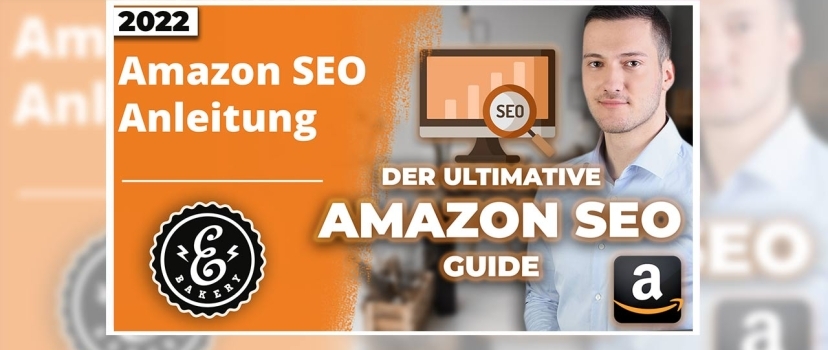Amazon SEO Guide
How to optimize your Amazon listing
In this Amazon SEO guide we show you by which parameters you can optimize your Amazon listing. We explain what keyword research is, how you implement it and go through the whole thing with a negative and a positive practical example.
Amazon SEO Guide - What to consider
To begin with: Amazon SEO means that we want to achieve with our offer text that our product can be found well in the catalog. What does it mean? Amazon customers generally always search for keywords. Now, when a customer wants to buy a product, it is not that the customer randomly browses the catalog somewhere, looks at the categories, but customers always enter search terms, so-called keywords, to find your product. These keywords can be researched, you can look at how often these months are entered, how the seasonality is, whether there is a change in the entries per month, the search queries. We can also determine if a product may have multiple search terms, means customers do not enter all the same word one to find a product. Sometimes there are also many search terms for one product. And the goal of the SEO or the SEO is that we make our product findable on these search terms. Why? As soon as we can be found on search terms with our product, the customers click on the product in the best case, buy that, we have our complete profit margin even without advertising.
The 4 parameters
Let’s go through the contents a bit. What is SEO actually all about? What does it include?
Real quick – quasi Amazon SEO consists of the product title, bullet points, description and backend keywords, that’s the most important thing.
01. the title already knows each seller, is limited above in length and should include all the important keywords.
02. the bullet points are these five bullet points that you can include in an offer. There are some categories where bullet points are not allowed or work a bit differently. However, 90% of the offers can add bullet points. For new merchants very important – by default there is only one bullet point, you can add them in the backend, that is in the settings at the product. Five pieces are very common, and there are certain rules that I will go into in a moment.
03. the next would be the description. Does the product description normally mean for non-brand owners, this is just such a block of text in which you can not get very creative with the display of the whole.
04. the last are the backend keywords. You can’t find that as a customer, so to speak, but only the seller can edit these backend keywords. This simply works in the inventory under “Edit”, and then there is a tab that is called search terms and general keywords. Keywords would also be placed there once again.
Amazon SEO Guide - Keyword Research
What is the process now if I as a merchant want to say, “Okay, I’m building a solid SEO listing, I want the Amazon SEO to be worked off well”? First and foremost, keywords need to be researched. Means about software solutions, as for example: Jungle Scout, Helium 10, AMZ Scout or meanwhile also with Amazon itself integrated already, one can pick out the search words for his product. Means, one sells a certain product, must clarify in advance which search terms are relevant for it, how often are they entered, do they have enough volume in the month that one should really focus on them. You do a keyword research, so to speak. As always in our videos all the things I describe today can of course also be done via eBakery. We can help him with this, just write message.
On the subject of keyword research: You look for all relevant terms for your own product, sort them mostly by search volume and my tip is that we should only include keywords that have at least 500 or 1000 searches per month. If the keywords are much smaller, it is usually not worth integrating them into the text. They take up space and have so little search volume that they may end up not generating any sales actually.
Structure of the LIsting
What is the structure? We have the title at the top. Here is important: the title can be maximum 200 characters. Amazon itself now recommends 150 characters, even less in some cases. As a rule, we always include between 150 and 200 characters in the creation. Means in the title we pack all important search terms purely, and I show then immediately again two examples, once good SEO, once less good SEO, then you see that again. So in the title should be all the important keywords, the title should still be halfway readable and we just have to make sure that we don’t have more than 200 characters in it, so we are pretty much limited in the amount we can place the title.
Amazon SEO Guide - The Bulletpoints
In the bullet points the whole thing is already a bit more flexible. Here you can insert a lot of text. But it is very important to say, only the first 1000 characters are indexed. What does that mean? When I write the bullet points – I’ve now written 5 bullet points, that’s a total of 2000 characters as an example – only the first 1000 characters are read by Amazon, so the first 1000 characters and their content and then the search terms in these 1000 characters are used to virtually place the product on these search terms. That it can be found there. All the keywords that come after these first 2000 characters, if no longer indexed, means they have absolutely no value as far as our ranking is concerned, as far as our discoverability is concerned. Means in the best case keep the bullet points reasonably short, maximum 1000 characters is the recommendation five pieces of 200 characters works very well, for example.
The description
The description – I think currently up to 2000 characters or more. But here I must say quite clearly: the description has on our ranking in the catalog, on the findability almost no influence, very little. Furthermore, many merchants use HTML codes to make the description a bit more descriptive and a bit quicker to show what it’s all about so it’s not just in the text block. Very important: HTML codes are almost all not allowed. The only thing that is allowed are line breaks, as soon as you use HTML code that adds more functions, this is actually not allowed by the guidelines. Currently, this still works in the catalog, but in the future, listings may also be deactivated if HTML is used too much.
What are backend keywords?
The last point is backend keywords. That’s kind of in edit the product really the point where you say “okay, general keywords” there we would also insert all the important keywords – up to 150/200 characters again – so similar short as the title. Unfortunately, this no longer counts very strongly in the ranking. I’ve placed a few stars here like this, you see that. Title: 5/5 stars. Why? The title has the very biggest impact as far as SEO is concerned, after that the bullet points, description and backend keywords have very little impact on ranking. So this means: Please make sure that the title and these bullet points really contain the most important search terms. What else can be said: double mentioning of keywords does not help anymore, means if now the same keyword placed 10 times in your SEO that did not help the ranking once is actually enough, that should be noted.
More about backend keywords
The next thing is: make sure that the keywords are placed sensibly. Keywords with a lot of search volume, with really a lot of relevance, best the title and then keywords that are still relevant but maybe have smaller search volume or not, not super relevant to appear anymore, then maybe in the bullet points, description and backend keywords as said have almost no impact.
Amazon SEO Guide - Why do keywords play such a big role?
Now why do we even want to place all these keywords in our SEO? Very simple. As an Amazon retailer, we live off the fact that customers who are on the platform find and buy our product and that too without advertising. Means Amazon merchants for the very most part generate their profits through organic sales. Means customers who are on the platform, find us without advertising, buy us without that we pay advertising thereby we draw our profit. If we are not able to be found on our search terms, we will not generate organic sales and therefore no profits in the normal case.
A misconception about SEO that I see again and again is that good SEO also means good ranking, i.e. good visibility. It is not so. It is very important to note here that SEO is used to show Amazon on which keywords we should be found, so where should we be found in the first place. Good SEO does not yet mean getting on the first page or being shown at the top of the first page. Good SEO causes that we can generate visibility at all on these terms, i.e. can generate ranking and then climb up bit by bit in the ads.
Why good Amazon SEO does not necessarily lead to better rankings
No matter how great you write your SEO, you still won’t generate rankings from it. The ranking comes for the very most part from sales. The SEO is the basis for generating any ranking at all on these terms, so that Amazon knows where to place you somewhere. But very important: the ranking comes from sales, not yet from the fact that somehow keywords are well placed here, that would be a bit too easy, unfortunately.
We now go to the next example times on how SEO can be quite good and also rather bad. I have now chosen two offers, this randomly chosen simply from two categories in which I was traveling. We have once a yoga mat and once name tags and I go through again very quickly and show you first the worse listing, the name tags. We have no connection to either product it’s just for descriptiveness.
Negative practical example
I had said yes in the title all important search terms up to 200 characters. If we look at the listing here now, we have only one word in the title, which is also quasi already plural directly here is somewhere still a comma with stuck for some reason. That would be absolutely insufficient for the title. Amazon knows now quasi only “okay I have to classify this product somewhere in the term name tags”, but all other search terms that would be relevant, except name tags, so name tag, name tag magnets, name tag clothing, name tag table, quite a few other terms that would actually be super, do not occur here. Is already called the title and to be enough.
The bullet points here in the area are now five pieces, number fits, length is also so far halfway okay, however, it is kept relatively short and also contains almost no search terms. You see this here we have name tags as a search term again, if I look through here now there is another term that would be super, “name display” maybe still yes but that’s kind of just two search terms in all the bullet points. The rest is slow sometimes product descriptive. The next big tip: we don’t use SEO to sell, we use SEO so that the customer can find the product and Amazon knows where to find it. The sale of the products, so to speak, to convince the customer to buy the product, happens to 90% in the photos and the price and maybe videos at the present. We really use the texts for the product to be ranked. We look into the description briefly, the description is super short, I find now not bad because I’m like I said the opinion that the description in the ranking makes almost nothing. Overall, one can say insufficient. Here you could technically improve text a lot and adjust the SEO.
Positive practical example
Let’s look at the next listing. Here we see now already other product. Let’s look at the title again: We see here directly that is a yoga mat, but what else is search terms we have yoga mat, yoga mat non-slip, sports mat, gym mat, fitness mat, exercise mat. Yoga mat as two terms. Alone in the title already very many search terms placed, super made and there Amazon knows exactly that one should be findable here many terms. The keywords in the bullet points are also better again. You’ll see five bullet points, a little emoji in front of it – that’s usually okay if you do that – about 1000 characters, I’d guess so looks very neat from the length here. And here again yoga mat, mat we look sports mat, what else do we have? Yoga mat again here, fitness mat again yoga mat. The most important terms were already titles, so there were not so many new ones, but in principle the SEO did a good job. And here we also notice that there is no longer a normal description, but a brand description. It’s called A+ or Enhanced Brand Content. Here we can virtually replace this boring description that simply consists of the text block here, or a line in the case even we can, and can even virtually insert photos with texts that helps a ranking unfortunately not at all. But the description would not make anyway. Therefore, you can here virtually this trademark description which is available only to trademark owners. We can use this to sell the product even more strongly. These are the two examples.
Amazon SEO Guide - Interim Summary
So, in summary, we can say we use Amazon SEO not to sell the product, but so that we are ranked on our keywords by Amazon, so that Amazon understands where in the catalog we should be visible. The whole thing doesn’t give us visibility yet unfortunately, so just through good SEO we won’t have 100 more views tomorrow by itself as I said, but we can show Amazon where we should be ranked when we turn on the marketing later (so the PPC campaigns) we can more easily generate rankings, i.e. visibility, on these terms, which then leads to profits. Alone the SEO not yet, that is virtually only the cornerstone and later to build ranking and then to manage really well.
Amazon SEO Guide Summary
No matter how great you write your SEO, you still won’t generate rankings from it. The ranking comes for the very most part from sales. The SEO is the basis for generating any ranking at all on these terms, so that Amazon knows where to place you somewhere. But very important: the ranking comes from sales, not yet from the fact that somehow keywords are well placed here, that would be a bit too easy, unfortunately.
We now go to the next example times on how SEO can be quite good and also rather bad. I have now chosen two offers, this randomly chosen simply from two categories in which I was traveling. We have once a yoga mat and once name tags and I go through again very quickly and show you first the worse listing, the name tags. We have no connection to either product it’s just for descriptiveness.
Summary
So you’ve learned that SEO is mandatory on Amazon to first have the opportunity to rank high for certain keywords, search terms that customers enter. However, if you take all of Lorenz’s tips to heart, this does not mean that you will land directly in first place. Other mechanisms play a role here, such as ratings, number of sales, etc. Therefore, you can’t avoid the topic of Amazon PPC, especially at the beginning. We have already shot a tutorial for you and have also linked it in the upper right corner.
Apart from that, you now know the 4 levers: title, bullet points, description and backend keywords and you know what value is attached to them. Clearly, the title and bullet points dominate. Sets a focus very clearly on this. Note the points that Lorenz has mentioned to you or watch the video again so as not to miss any of the points mentioned. I hope we could give you a little insight into the Amazon SEO area. If you have any questions or if you want to leave the optimization to the professionals, please feel free to make an appointment with us. We are happy to help you as Amazon SEO agency, Amazon PPC agency, but also general Amazon agency.
Do you have questions or need an individual offer? Do not hesitate to contact us.
- 0/5
- 0 ratings
| Very bad! | Bad | Hmmm | Oke | Good! |
|---|---|---|---|---|
| 0% | 0% | 0% | 0% | 0% |
Haben Sie Fragen oder brauchen ein individuelles Angebot? Zögern Sie nicht, uns zu kontaktieren.



















